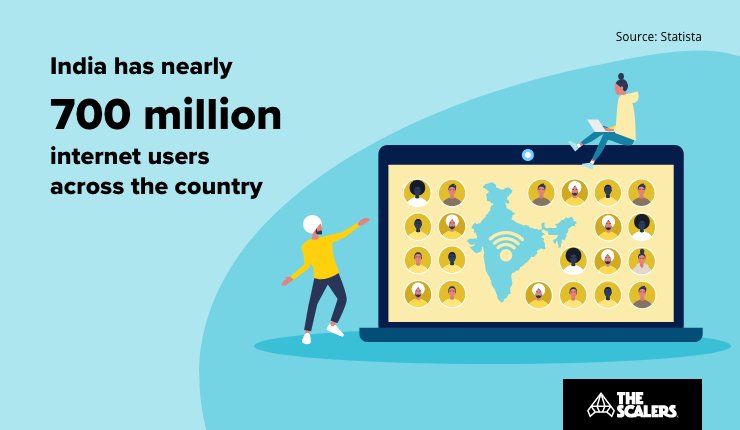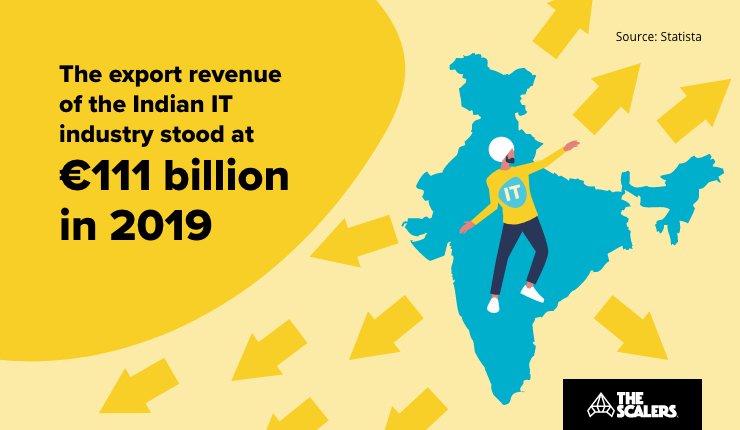The past few decades have seen staggering technological changes that have revolutionised the world. Technology has created hundreds of thousands of tools and resources, making it possible to access any information literally at our fingertips.
Over 4.33 billion people actively use the internet today. That’s a mind-boggling 56% of the global population, where India ranks second. And it’s only going uphill from here.
IT technology in India is advancing at an astonishingly fast rate, and those who can’t keep up are simply left behind. Technology has changed the way we communicate, how we pay our bills, and even how we watch TV. There’s no doubt that the IT industry is growing like never before. The question is – can you leverage the IT talent in India to stay ahead of your competitors? Is India at the forefront of technological innovation? Let’s find out.

How to beat local skill shortages and set up your development centre abroad
DOWNLOAD GUIDEIT Technology in India: The Past
In the past, India has often seemed to be a bit of a relative laggard among developing countries, especially in terms of economic growth. However, what changed that was the IT revolution in the country that led to the Indian software industry being recognised as one of the most successful in the world today.
The late 1970s saw a boom in the IT industry with the outsourcing of software to specialised software firms. It was quick, easy, and in the unknown land of technology, it was convenient. The early 1980s were all about “prepackaged” software because of the acute shortage of talented engineers who could build custom software.
However, the 1990s saw a resurgence of project-driven software services that ignited the mushrooming high growth rates in the Indian software industry. Soon the local industry established itself, and multinationals began to set up their own development centers in the country, starting with Texas instruments in 1986.

in Bangalore
Speed up your software delivery with an integrated and dedicated team
LEARN MOREThe rest is truly history! Since the early 1990s, the Indian IT industry has been growing at a phenomenal rate with several phases of growth and development over the last three decades. Today, India stands tall as one of the largest digital hubs in the world. Digital technology, Artificial Intelligence, Cloud Computing, etc., are all common words in the country.
What can we expect in the next 20 years?
There’s no doubt that the world will drastically change with technology and innovation in the next 20 years. And as a stakeholder in an IT company, it’s crucial to know which technologies to implement so your business can stay ahead of the competition and generate significant profits.

Here are some IT technology advancements that are going to be BIG in the next 20 years
Internet Of Things (IoT)
A recent survey conducted showed that over 86% of the respondents plan to increase their IoT spends significantly over the next couple of years. The survey also went on to say that enterprises in the US spend an average of $4.6 million in 2018 on IoT, to digitally transform their business models. The next 20 years will see sensors incorporated on machinery, equipment, heating units, security systems, and pretty much everything – and IoT will play a significant role in this.
Artificial Intelligence & Robotics
Though the concept of Artificial Intelligence is well over 60 years old, it has only become popular in the last decade. With passive operational power and storage, AI can transform business strategies like no other. Self-driving cars, robotics, new teaching methods, and even personalised medicines – AI is set to take over, and take over it will.
Augmented Reality
Augmented reality is no longer science-fiction, thanks to the IT technological advancements in the last decade. While earlier, the costs associated with AR meant that projects were few and far apart, today, technology has made it possible for AR to be available even on the mobile handset. In the future, Augmented Reality will find its application in education, art, architecture, military, and navigation – the possibilities are truly endless.
Where is India in this everlasting IT race?
In a nutshell, right at the top.
India is a country that produces over 1.5 million engineers year after year – a number that is only climbing. That means that some of the best tech talents in the industry are in India. And that’s not all. India is also the leading sourcing destination in the world, accounting for over 55% of the market share of the US sourcing business. With over 1,000 global delivery centers across 80 countries, India is now the digital hub of the world.

Bangalore, one of the most dynamic cities in the world, also known as the Silicon Valley of Asia, is in India. Bangalore is home to multinational software companies, hundreds of start-ups, and tech companies that implement the latest technologies to deliver new products to the market. The future is here, and it’s definitely in India.
Will offshore software development prove beneficial?
Implementing the latest IT technology requires cutting-edge software and the best engineers. Though cutting-edge software is easy to procure, the acute shortage of talent in the West poses a significant challenge. With more engineering vacancies than ever, more and more companies are turning towards the only sustainable solution – offshore software development.
By going offshore and establishing a development centre in a country like India, companies can gain access to a massive talent pool of world-class engineers, just waiting to be hired. These English-speaking engineers are tech experts, and dedicated and hard-working individuals who become a value-adding extension of your existing workforce.
Another underlying benefit of going offshore is the lower operational costs. Owing to the low cost of living in Asian countries, you can significantly save money on the payroll, employee-centric benefits, rent, and other administrative costs.

How we helped Preqin establish a 450+ person global R&D centre in India
DOWNLOAD CASE STUDYThese benefits have also contributed to large corporations such as Google, Microsoft, SAP, and Intel establishing their R&D centres in Bangalore – the Silicon Valley Of Asia. They implement the latest IT technology to build software that is new and innovative, without compromising on the quality or speed of delivery.
If you want to know more about the IT industry in India, and building a development team in Bangalore, feel free to reach out to us by filling out the contact form. One of our senior executives will get in touch with you within 24 hours.
















